To many a wine expert, Riesling is amongst the world’s finest white wine grape varieties, perhaps thanks to its versatile nature. The aromatic grape does well as both a sweet and dry wine, to drink straight away or suitable for long-term ageing. This week Wine Lister looks at the top five Rieslings under £100 by Quality score, which all hail from Alsace or the Mosel.
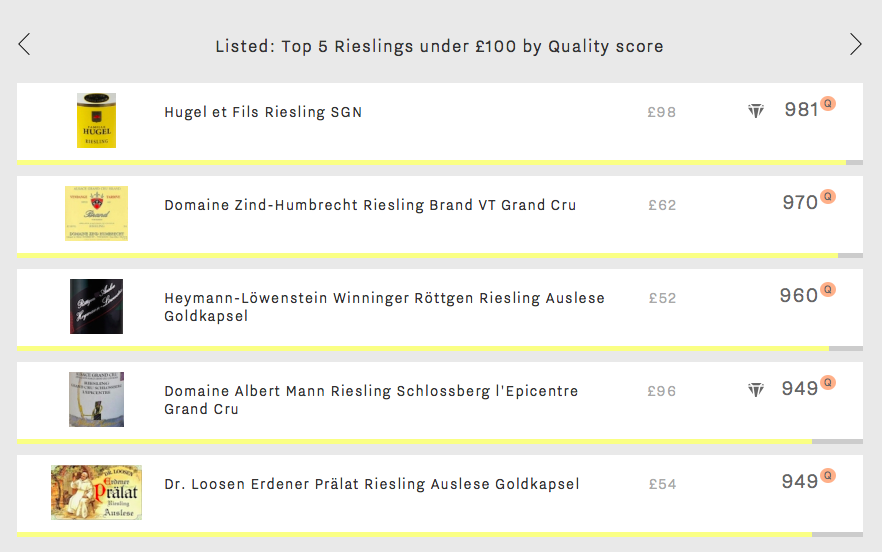
Hugel et Fils’ Riesling SGN takes the top spot this week with a Quality score of 981. This phenomenal Quality score is in part the result of an average wine life of 24 years (compared to 13 years for the rest of this week’s top five). The Riesling SGN from Hugel is therefore perhaps justifiably this week’s most expensive choice, at an average price of £98 per bottle in-bond. Sadly, it might take a Christmas miracle to source this in time for next week’s festivities. An average of just 600 bottles are produced of this Wine Lister Hidden Gem each year.
Next is Domaine Zind-Humbrecht’s Riesling Brand VT with a Quality score of 970. Though in second place for Quality, it achieves this week’s best Economics score of 633 (and also this week’s best overall Wine Lister score) – despite only 18 bottles of it having been traded at auction in the last year. It is the short-term price performance that really boosts the Economics score – the price having increased by 17% in the last six months.
In third place is this week’s first German wine – Heymann-Löwenstein’s Winninger Röttgen Riesling Auslese Goldkapsel. It achieves a Quality score of 960, and at only £52 per bottle in-bond it is this week’s most affordable option.
The two remaining spots of this week’s top five share the same Quality score (949). Domaine Albert Mann Schlossberg l’Epicentre Grand Cru is this week’s second Hidden Gem. Its Hidden Gem status is confirmed by a modest Brand score of 255 – the lowest of the group, due to presence in just 1% of the world’s top restaurants, and being only the 3,797 most-searched-for of Wine Lister’s wines on Wine-Searcher.
Rounding off the group is the second Riesling from Germany, Dr. Loosen Erdener Prälat Auslese Goldkapsel. If you are looking for Quality look no further than its 2006 vintage, which achieves a Quality score of 975 at an average price of £44 per bottle in-bond (compared to the wine’s overall average price of £54 in-bond). Its excellent quality-to-price ratio earns it a spot as one of Wine Lister’s Value Picks – indeed, it is given high praise from Wine Lister partner critic, Antonio Galloni, claiming it to be a “…massive and yet somehow delicate auslese of stunning quality”.
‘Tis the season of dark evenings, woolly jumpers, and open fires. To round out the perfect winter evening, Wine Lister has many a drinking suggestion up our collective cashmere sleeves, but let us start with these top five 20-year-old Châteauneuf-du-Papes by Quality score.
Unsurprisingly, the Southern Rhône beats its Northern sibling for price to quality ratios, with the average Quality score of the top five 1998 Châteauneuf-du-Papes at 968, for an average in-bond price per bottle of £354. Comparatively, the Northern Rhône’s top five 1998 average Quality score is 959 for an eye-watering £882 per bottle.
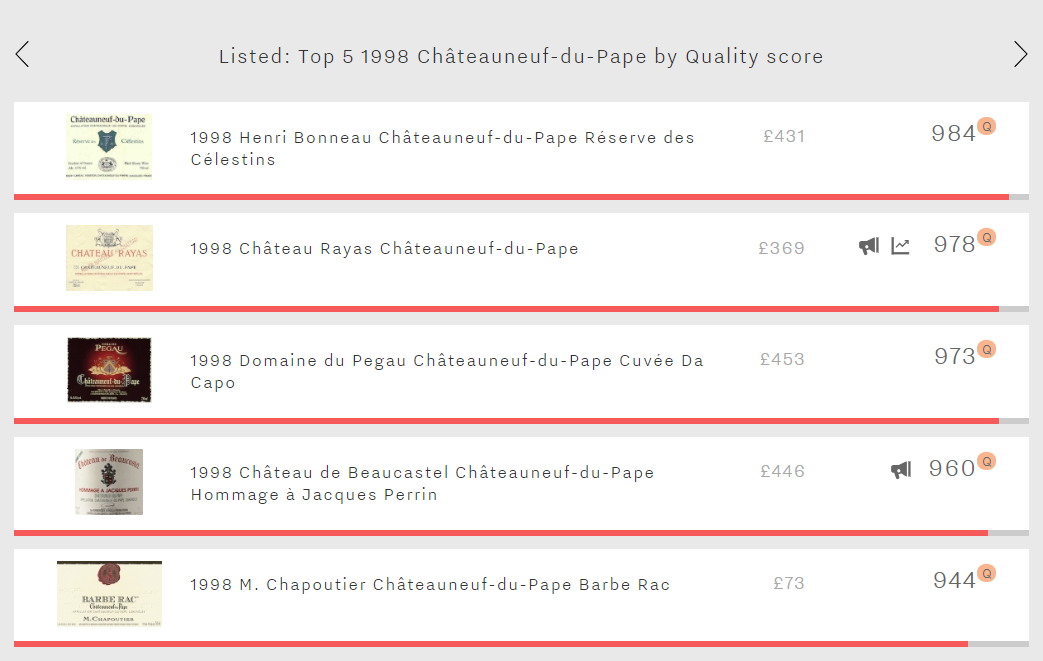
In first place of this week’s top five is Henri Bonneau’s Châteauneuf-du-Pape Réserve des Célestins. Its Quality score of 984 for the 1998 vintage is not only the best of this week’s top five, it is also Bonneau’s highest of the last 20 years, for £431 per bottle in-bond. This price tag is thanks to solid short- and long-term price performance, with six-month price growth of 16.9% and a three-year compound annual growth rate (CAGR) of 16.2%.
Next for 1998 Châteauneuf-du-Papes by Quality score comes this week’s best brand, Château Rayas. Its Brand score of 982 is thanks to presence in 33% of the world’s best restaurants, and an impressive search ranking as the 53rd most-searched-for wine on Wine Lister. Wine Lister partner critic Jancis Robinson awards it full marks, describing it as “not dissimilar” to Rousseau. Its impressive quality and popularity are complimented by the highest Economics score of this week’s top five (988) thanks to the top six-month price performance of 21.7% and a three-year CAGR of 25%.
In third place is Domaine du Pegau’s Cuvée Da Capo 1998 with a Quality score of 973. It is the most expensive of this week’s top five, at £453 in-bond per bottle, perhaps due to its cult-style following. The Cuvée Da Capo achieves the highest average trading volumes at auction of the group (408 bottles per year), according to The Wine Market Journal.
The fourth wine of this week’s top five may also be said to have somewhat of a cult following. Beaucastel’s Hommage à Jacques Perrin 1998 is priced at £446 per bottle in-bond for a Quality score of 960. Despite this excellent score, eight of its last 15 vintages have managed even better Quality scores than the 1998 – indeed Hommage à Jacques Perrin is on average the highest-scoring Châteauneuf-du-Pape on Wine Lister (with an average Quality score of 965).
Finally, M. Chapoutier’s Châteauneuf-du-Pape Barbe Rac 1998 rounds out the group, with a Quality score of 944 and a price of £73 per bottle in-bond (or a mere 17% of the average price of the other four wines combined).
Other than the Rayas, any lucky owners of these bottles should consider cracking them open this Christmas, lest he or she risk missing their respective quality peaks.
Our latest Listed blog focused on the top Grand Cru Champagnes by Wine Lister score. As the holiday season approaches, we look at a different kind of ‘top five’ on a sparkling theme – five of the major trends for the Champagne region, determined by a recent survey of Wine Lister’s Founding members.
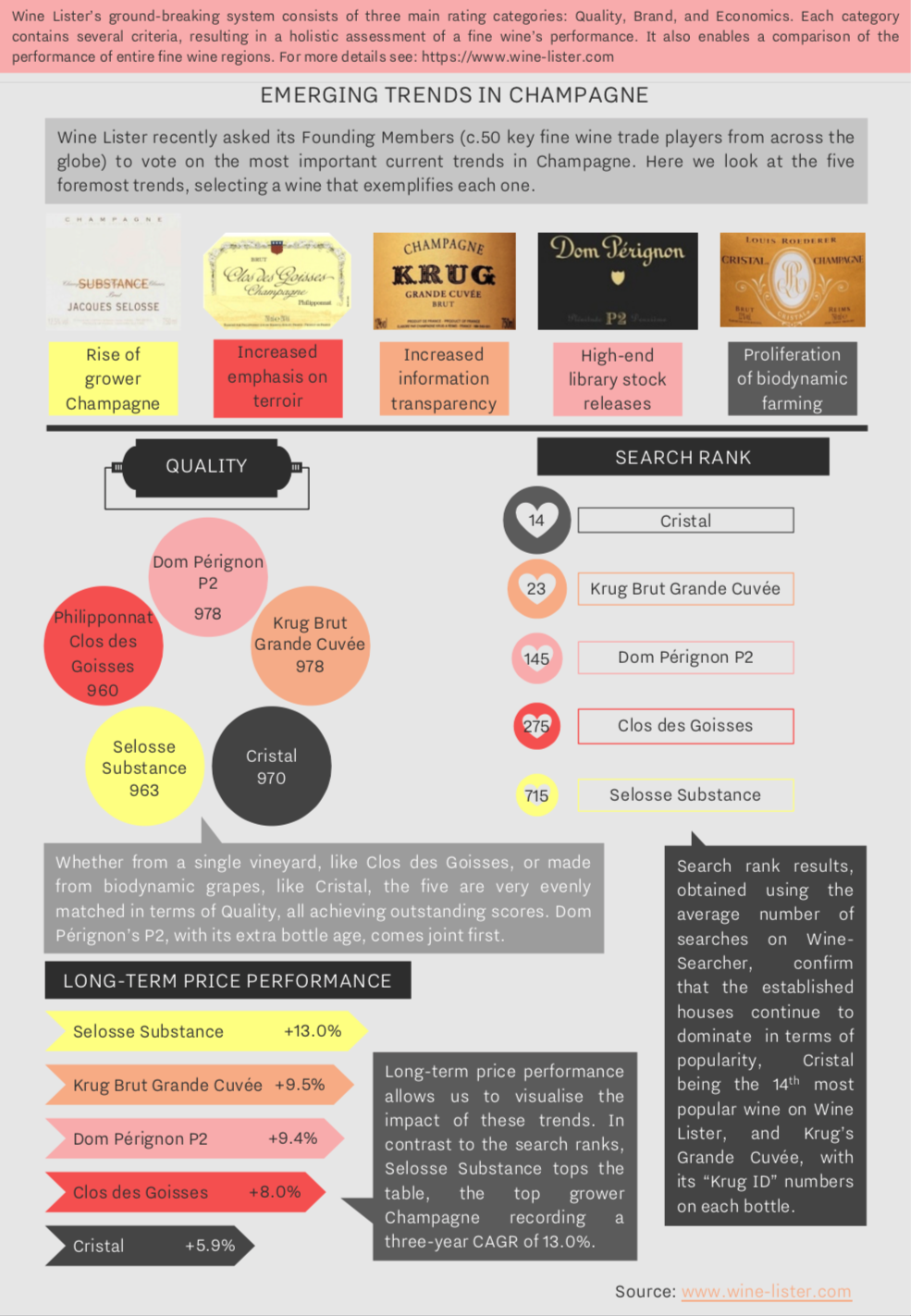
Key members of the global fine wine trade identified the rise of grower Champagnes as an emerging trend. Jacques Selosse reigns supreme, with its Blanc de Noirs La Côte Faron achieving the best Quality score of any grower Champagne on Wine Lister (975). Only an average of 1,250 bottles are produced of this each year – half of the production volume of its Substance Brut.
Founding Members also identified an increased emphasis on terroir as something to look out for. Single vineyard expressions of Champagne are well-known and already extremely sought-after, particularly Krug’s Clos du Mesnil and Clos d’Ambonnay. The latter achieves a Quality score of 970, just 10 points above Philipponnat’s Clos des Goisses, but is over 12 times the price (£1,867 vs. £147).
The phenomenon of increased information transparency is perhaps a sign that buyers are becoming more interested in Champagnes as wines, as opposed to just celebratory bubbles. Krug’s Grande Cuvée has used “Krug ID” numbers since 2011, allowing drinkers to see the vintages, vineyard plots, and grapes included in each bottle. Library releases also cater to more “wine-focused” buyers – Champagne Brand King Dom Perignon’s P2, or Bollinger R.D. are the obvious choices for this.
Finally, interest in biodynamically farmed Champagnes is on the rise, such as Louis Roederer’s Cristal, or any cuvée from Jacques Selosse.
Download a PDF of the slide above here.
First published in French in En Magnum.
Wine Lister recently looked at red Christmas drinking options with the best Bordeaux under £50, and now that the official ‘sparkling season’ is almost upon us, it is high time to consider options for holiday bubbles. Below we examine the all-round best of the best – the top five Grand Cru Champagnes by Wine Lister score.
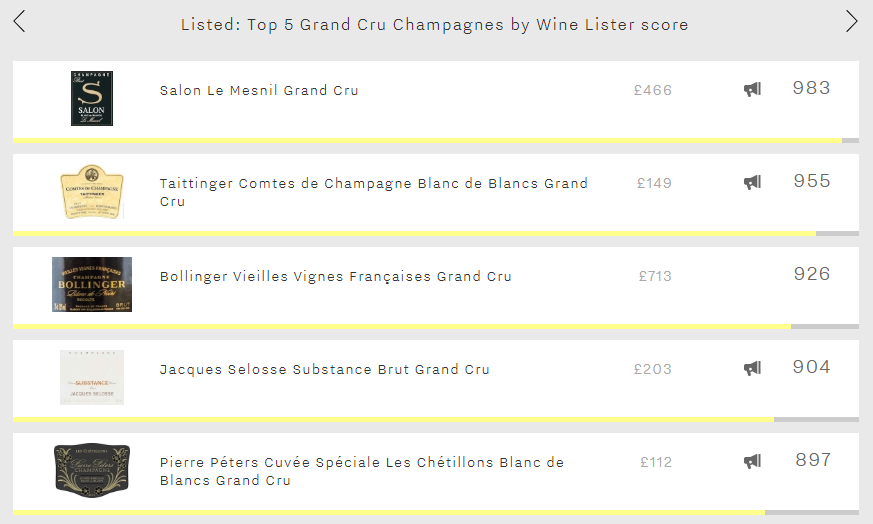
The number one Grand Cru Champagne is the indomitable Salon Le Mesnil (983). It fires on all Wine Lister cylinders, with impressive Quality, Brand, and Economics scores of 980, 989, and 981 respectively, meaning that it leads this week’s top five across each category. Moreover, it is the number one white wine on Wine Lister – still, sparkling, dry, or sweet. If you’re after a memorable bottle to kickstart the holiday season, then look no further than Salon 1996, its best ever vintage. As proof of the extraordinary longevity of top Champagne, the 1996 will be drinking well until at least 2025. Though expensive (£550 per bottle in-bond), you would be well-rewarded for paying the high price, Antonio Galloni calling the 1996 “the ultimate expression of Champagne as a wine”.
Next comes Taittinger’s Comtes de Champagne, whose main strength is its Brand score (976). This is helped by a production volume of c.170,000 bottles per annum – almost twice that of the other four Champagnes of this week’s group combined. It consequently also achieves the highest auction-trading volumes of the group, having traded 789 bottles over the past four quarters, according to our data partner, The Wine Market Journal.
In third place is Bollinger Vieilles Vignes Françaises. The term “vielles vignes” tends to get banded around quite frequently without much meaning, but in this case it carries rare significance. These old vines are planted on French rootstock, predating the spread of phylloxera which lead to the introduction of louse-resistant American rootstock onto the vast majority of France’s vines. As might be expected given the wine’s unique heritage, it comes with a hefty price tag (£713 per bottle in-bond). However, this rarity backs up its high price with an outstanding Quality score (963) – the joint-second best of this week’s top five.
In fourth place is Jacques Selosse’s Substance Brut (904). The only non-vintage wine of the five, it matches the Bollinger Vieilles Vignes Françaises’ excellent Quality score (963). Its outstanding quality, coupled with its tiny production volume of 2,700 bottles per annum, start to explain the £203 price-tag of this NV grower Champagne.
Finally, in fifth place, is Pierre Péters’ Cuvée Spéciale Les Chétillons Blanc (897). Though in fifth place, its impressive Quality (923) and Economics (922) scores suggest it could be a prime choice for cellaring. It achieves the best short and long-term price growth of this week’s top five, having added 16.7% to its price over the past six months, and recording a three-year compound annual growth rate (CAGR) of 36.5%. Any recent vintage would perhaps therefore be better placed under the Christmas tree (for an extremely lucky recipient), rather than on the Christmas table.
Thanks to tiny production quantities, exceptional quality, and increasing popularity, Burgundy tends to be expensive. In Wine Lister’s Burgundy Market Study (published in January this year), we analysed its rapidly-climbing prices. This week’s Listed blog focuses on the very tip of the Burgundy price hierarchy, with the top five by average price.
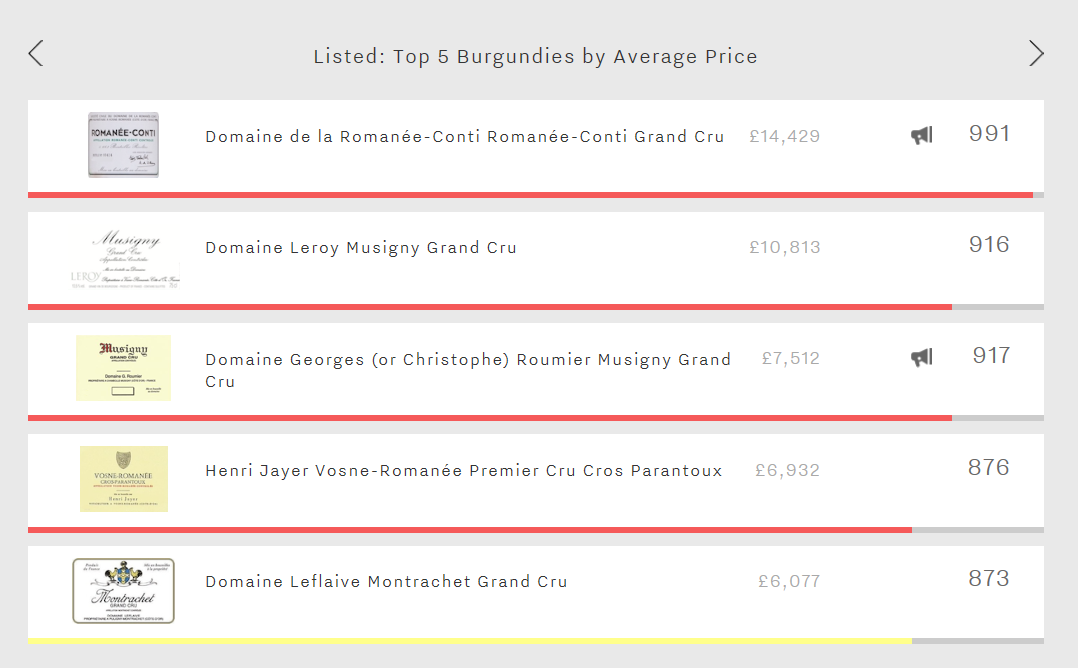
Four of this week’s top five hail from the Côte de Nuits, the first of which is, unsurprisingly, Domaine de la Romanée-Conti’s Romanée-Conti at an average price of £14,429 per bottle in-bond. The high price tag is accompanied by the best red Quality score on Wine Lister (993) and a Brand score of 989. The latter is achieved in part by being the 8th most-searched-for wine on Wine Lister (and indeed gains two and a half times as many monthly searches on Wine Searcher as the remaining wines of this week’s top five combined). Its most recent release – the 2015 vintage, receives a Quality score of 997, with Wine Lister partner critics Bettane + Desseauve and Jancis Robinson both awarding it 20/20. Even if the 2015 vintage is DRC Romanée-Conti’s best-performing in the last 15 years, its price increase of nearly 500% (from £2,925 to £17,496) since release in January is virtually incomprehensible.
In second place is one of two Musignys to feature this week. Domaine Leroy’s Musigny has an average in-bond price of £10,813 per bottle and a Quality score of 988 – just five points behind this week’s number one. Its overall Wine Lister score sits 75 points down from DRC Romanée-Conti, due to a more modest Brand score of 781. Interestingly, Leroy’s Musigny has been qualitatively more consistent over the past five releases than Wine Lister’s highest-quality red – its Quality score deviates a maximum of just one point from year to year since 2010 (compared to DRC Romanée-Conti’s maximum deviation of seven points).
Number three of this week’s top five is the second Musigny, this time from Domaine Georges Roumier. With a slightly lower price tag of £7,512 per bottle in-bond, and the second-highest Brand score of the group, Roumier is somewhat a darling of the trade – indeed, this Musigny is in the top 10% of most talked-about wines by the fine wine trade, according to Wine Lister’s Founding Member Surveys.
The last two spots are taken by wines that each stand alone among this week’s top five for their own reasons. The first, Henri Jayer’s Vosne-Romanée Cros Parantoux at £6,932 per bottle is the only Premier Cru to feature, as well as the only wine no longer in production.
Finally, Domaine Leflaive’s Montrachet Grand Cru is the only white of the group. As the most expensive white Burgundy on Wine Lister at £6,077 per bottle, it also earns white Burgundy’s highest Quality score of 985.
To many wine collectors, the king of Italian wine is Barolo. Its popularity, particularly for older vintages, continues to grow (as proven in our latest restaurant presence analysis). However, the Piedmont sovereign’s Tuscan counterpart – Brunello – should not be overlooked. This week’s top five looks at the best Brunellos by Quality score – and all five achieve scores above 900.
Perhaps unsurprisingly, the top five Barolos by Quality score achieve an average score 34 points higher than this week’s Brunello group (964 vs 929). However, couple this with the fact that the Brunellos tend to cost nearly half as much as their Barolo counterparts (£142 vs £275), and Brunello’s value starts to become clear.
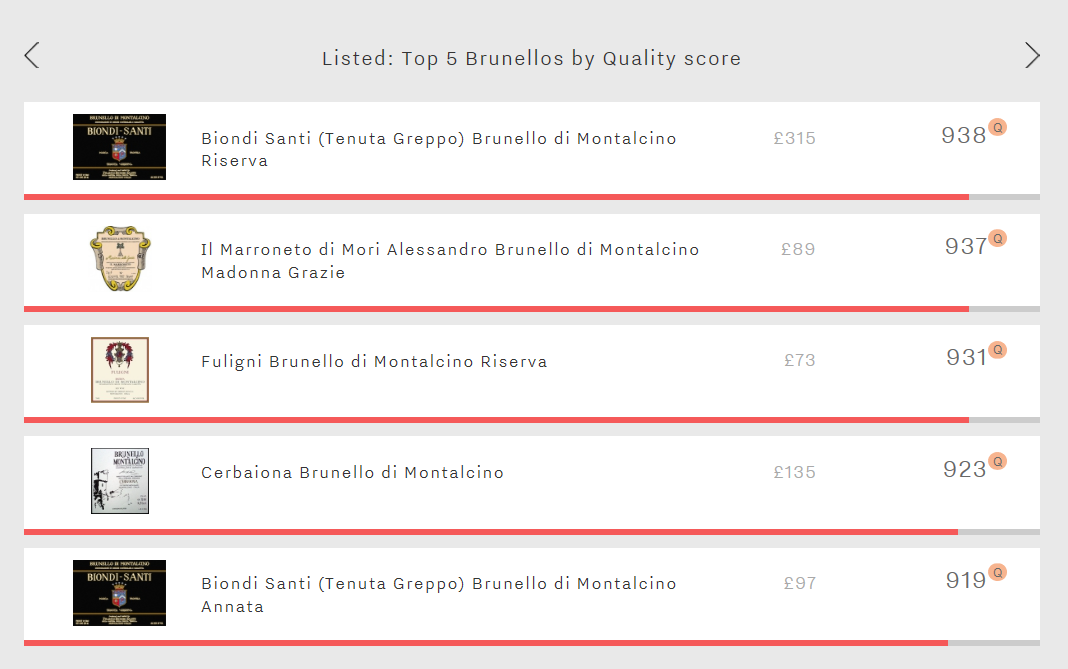
Biondi Santi earns two spots in this week’s top five, with its Brunello Riserva and Brunello Annata bookending the group. The former wins this week’s battle with an impressive Quality score of 938. It also achieves this week’s highest Economics score (941), contributing to its excellent overall Wine Lister score of 926 – also the best of the group. Although, at £315 a bottle it is also more than three times as expensive as the collective average price of the other four (£99).
In second place this week is Il Marroneto di Mori Alessandro Brunello Madonna Grazie. With a Quality score of 937 it is just one point behind this week’s number one – the slightly lower score being due to its shorter average ageing potential (12 vs 19 years). Its 2008 vintage provides the most impressive quality to price ratio of this week’s top five, achieving a Quality score of 938, yet available for as little as £45 per bottle in-bond.
Next in this week’s top five is Fuligni Brunello Riserva with a Quality score of 931. It appears to be the least well-known of the group, with a Brand score of 645. This is down to presence in just 5% of the world’s best restaurants, and being ranked 1,257th for monthly online searches of all Wine Lister’s wines on Wine Searcher. Its relatively modest Brand score could perhaps be the reason for its average price being the least expensive of the group (£73 per bottle).
Cerbaiona’s Brunello takes fourth place, with a Quality score of 923. Though not earning the highest Brand score of this week’s top five, it is still a Brand to watch – Cerbaiona was the only Brunello to feature in both recent top 20 lists for horizontal and vertical restaurant presence gains. Perhaps its increasing popularity is in part thanks to such an impressive score for the 2010 vintage. Vinous awards it 100 points, singing its praises: “The most anticipated wine of the night, the Cerbaiona shows why it belongs in the pantheon of the most epic wines ever made in Montalcino. A Brunello with no beginning and no end, the 2010 Cerbaiona just is. Every aroma, every shade of nuance, every texture is just…perfect.”
Last but not least is Biondi Santi’s Brunello Annata with a Quality score of 919. Though in fifth place for Quality, it achieves the highest Brand score of this week’s top five, at 934. This impressive Brand score is the result of great restaurant presence (17%) and being the 118th most searched-for wine on Wine Lister.
Last week we revealed the top 20 gainers in presence in the world’s best restaurants over the past 12 months. That was in terms of breadth, i.e. the number of restaurants in which a wine features. Wine Lister also analyses the depth of presence – the range of vintages and/or bottle formats of each wine therein. Here we look at the top 21 wines achieving the largest increases in restaurant presence depth since last year.
In first place, with an impressive 35 additional vintages and/or bottle formats listed across the world’s 150 best restaurants since this time last year, is Vega-Sicilia’s Unico. This brings its total references to 250 (almost three and a half in each of the 71 lists in which it features). Given Unico’s average drinking life span of 13 years, and its reputation for longevity (an Unico vertical tasting is an opportunity not to be missed), this result is hardly surprising. Its strong restaurant presence is matched by online popularity (Unico is the 33rd most-searched-for wine in our database), resulting in a Brand score of 992 – the best of any Spanish wine on Wine Lister.
Though Spain takes the number one spot, Italy is the overall biggest mover in increased depth of representation, claiming 12 out of the 21 places shown on the chart below.
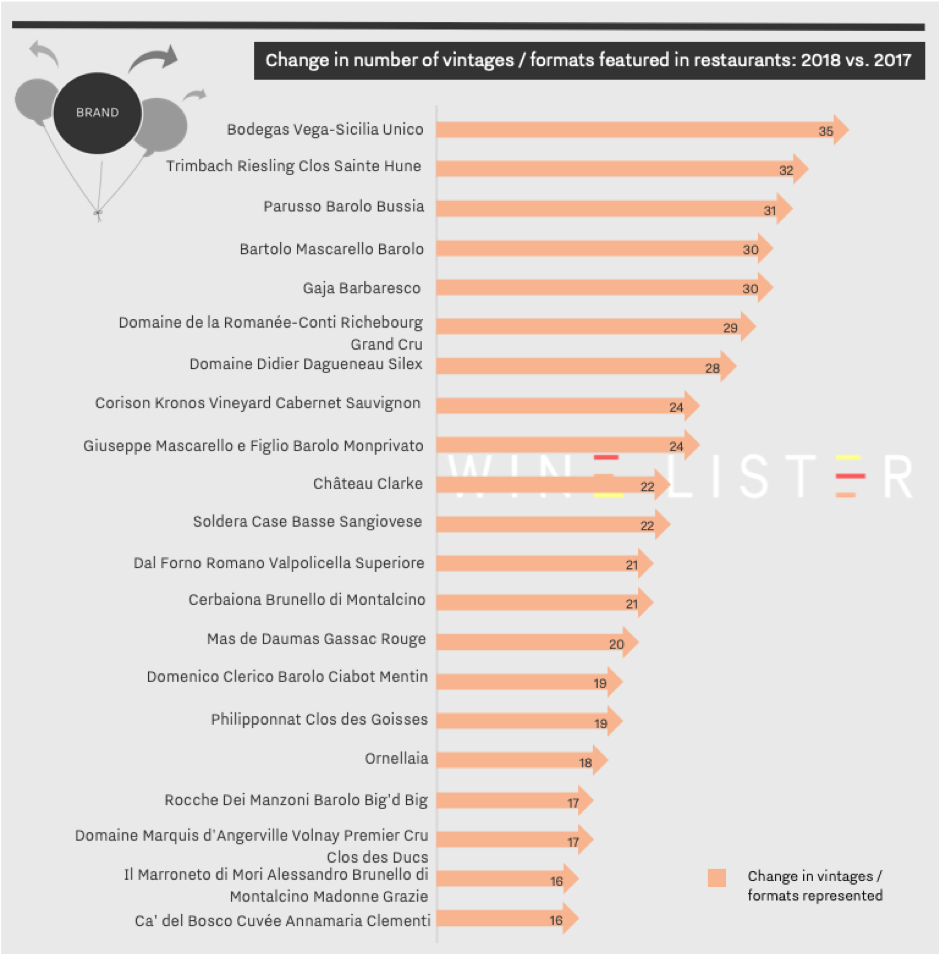
Ornellaia is among these, and is also the most thoroughly represented wine of the group, with 280 vintages and/or bottle formats featured across 43% of the world’s best restaurants.
Several others – Cerbaiona Brunello, Dal Forno Romano Valpolicella Superiore, Ca’ del Bosco Cuvée Annamaria Clementi, and Domenico Clerico Barolo Ciabot Mentin – feature in the top gainers for horizontal as well as vertical presence in the world’s best restaurants. The latter is one of five Barolos to feature in the chart above, joined by Parusso Barolo Bussia, Bartolo Mascarello’s Barolo, Giuseppe Mascarello e Figlio Barolo Monprivato, and finally, Rocche Dei Manzoni Barolo Big’d Big, which sees the biggest increase in vertical presence of the whole group. Despite a horizontal representation increase of just 1%, the number of vintages and/or bottle formats listed across the 3% of the world’s best restaurants in which it features has grown from two to 19 in the last 12 months (or in other words, by 850%).
Outside Italy, the overall picture of restaurant presence depth somewhat contradicts that of breadth painted last week. Though Champagnes, and in particular grower offerings, have increased significantly in terms of horizontal presence, their vintage and/or format gains have not been sufficient to make this week’s top 20. This suggests that whilst sommeliers are keen to add more variety of Champagne, they aren’t so worried about listing reams of vintages / formats thereof. Only one Champagne features in the group: Philipponnat’s Clos des Goisses.
Bordeaux is conspicuous by its absence in this list, other than Château Clarke, with 26 overall references up from just four. In fact, Bordeaux’s big names are more likely to find themselves at the very bottom of the list, many having seen their vertical entries on restaurant wine lists shrink significantly. This seems to suggest that as restaurants diversify, they are choosing to hold less Bordeaux stock, still listing the top wines, but not necessarily in multiple vintages or formats.
Even though Austria might not be the first place that springs to mind when one thinks of the best wines in the world, it is definitely a place of fine, elegant wines, as confirmed by this week’s top five, which looks at the best Austrian whites by Quality score. With all of the five achieving Quality scores of over 900-points – thus making it into the “strongest” category on Wine Lister’s 1,000-point scale – there is no reason not to have Austria in mind when thinking of top quality wines.
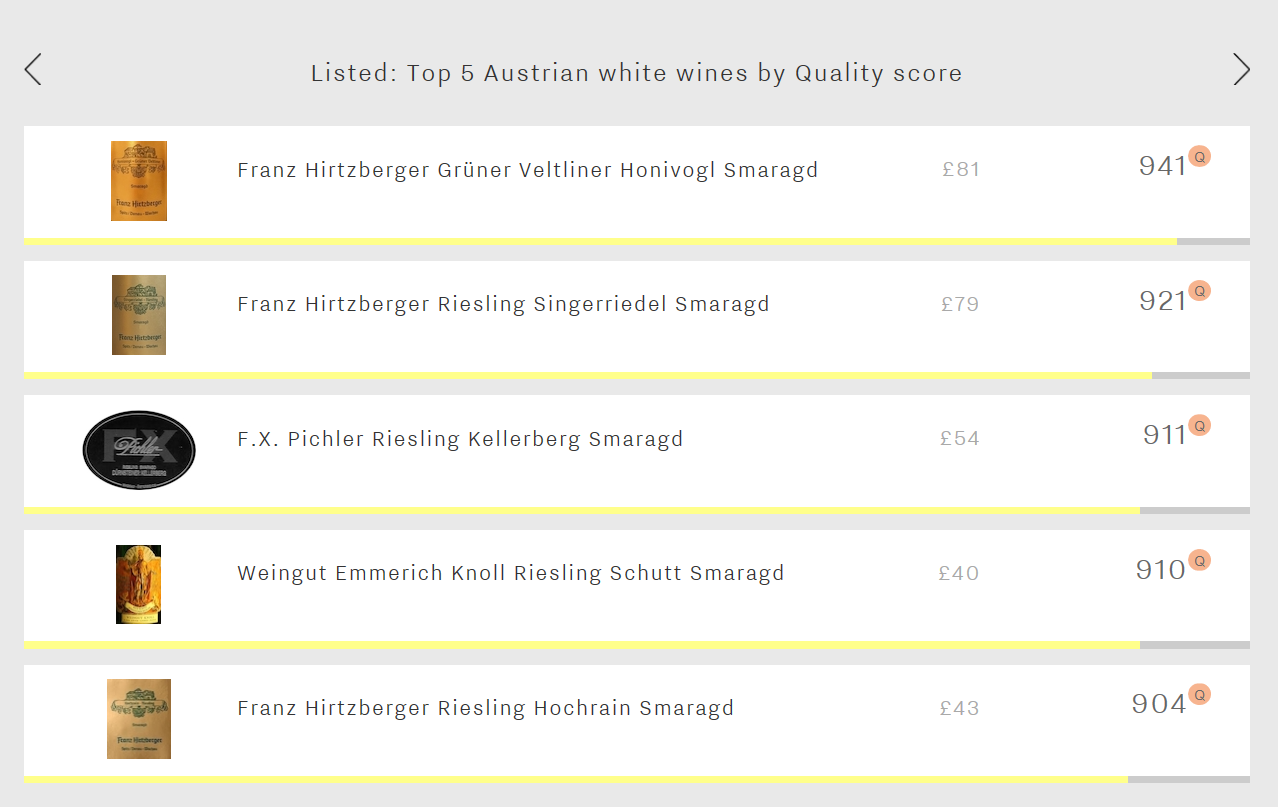
Notably, Franz Hirtzberger produces three of this week’s top five: his Grüner Veltliner Honivogl Smaragd, Riesling Singerriedel Smaragd, and Riesling Hochrain Smaragd demonstrating that he is indeed one of the greatest Austrian producers of dry whites. Leading the way this week is his Grüner Veltliner Honivogl Smaragd with a Quality score of 941. Interestingly, it is the only Grüner Veltliner of the group, with Austria’s national grape otherwise surrounded by Rieslings. At £81 per bottle, it is this week’s most expensive choice. However, it is also Jancis Robinson’s favourite of the five, Wine Lister’s UK partner critic awarding it an excellent average score of 18/20. She was particularly impressed by the 2013, giving it a rating of 18.5/20 and writing: “Spectacularly rich nose. Very ample, intense and flattering. Smoked meat! Kerpow! Not flabby. Great structure. Amazing”.
Franz Hirtzberger’s Riesling Singerriedel Smaragd comes next, and backs up its phenomenal Quality score (921) with this week’s best Brand score (760). Even though its Economics score is considerably lower (503), the Singerriedel is Austria’s overall top-scoring wine, with a Wine Lister score of 781.
F.X. Pichler’s Riesling Kellerberg Smaragd comes in at number three, with a Quality score of 911. This is Vinous’ favourite of the five with an average score of 95/100. Its Quality score is however pulled down slightly by its relatively low average wine life of seven years, making it the shortest-lived wine of the group (which averages nine years). However, it has the most stable price of this group, with volatility of just 2.7%, well below that of this week’s number one, Franz Hirtzberger’s Grüner Veltliner Honivogl, which has volatility of 11.8%.
The two remaining spots are filled by Weingut Emmerich Knoll Riesling Schutt Smaragd in fourth place, and the third wine from Franz Hirtzberger this week, his Riesling Hochrain Smaragd, in fifth place. Although the two come in last in this particular race, both still achieve excellent Quality scores (910 and 904 respectively), partly due to Vinous awarding both an average score of 93.5/100.
Wine Lister periodically studies the movements of wines in and out of the four Wine Lister Indicator categories. One of these, Buzz Brands, denotes wines that achieve outstanding online popularity (measured through search rankings based on monthly searches on Wine-Searcher), and presence in the world’s best restaurants.
After analysing newcomers to the Buzz Brand segment in June, Burgundy dominates once again in our findings for October. Red Burgundy, and in particular, Gevrey-Chambertin, takes three out of the four places of this month’s new Buzz Brands.
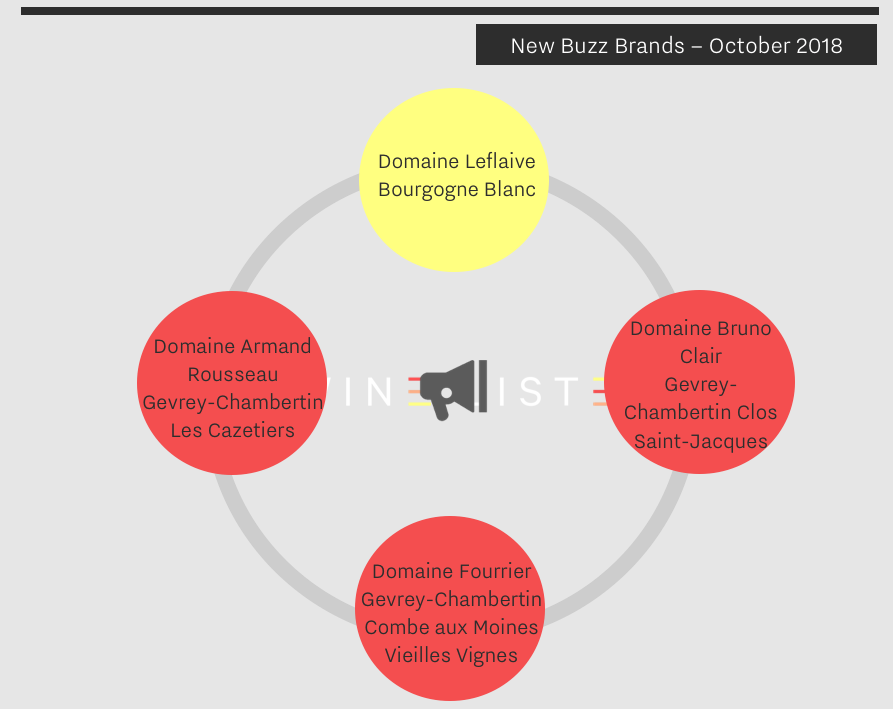
However, it is in fact the only white, Domaine Leflaive’s Bourgogne Blanc, that achieves the highest Brand score of the group at 815. All of the Domaine Leflaive wines on Wine Lister are now Buzz Brands but one – their most expensive Grand Cru, Montrachet (at £6,059 per bottle compared with £218, the average price of the rest). Indicative, maybe, of drinkers being priced out of the top wines and refocussing their interest lower down the ladder.
Perhaps it is also the sign of a good brand strategy in action, with the rising profile of the Domaine’s top wines filtering all the way down to the regional wines, via the premiers crus. The new addition of the regional offering here follows two previous new Leflaive mentions in Wine Lister’s last Buzz Brand audit (of Puligny-Montrachet Les Combettes and Meursault Sous le Dos d’Ane).
Of the three reds, two hold the same Brand score of 722, and near identical Brand profiles (see restaurant presence and search rank in the image below). The Gevrey-Chambertin Clos Saint-Jacques is the first of Bruno Clair’s wines to become a Buzz Brand. Domaine Fourrier’s Combe aux Moines Vieilles Vignes has the highest Quality score of all three new red Burgundy Buzz Brands with a score of 889. This, coupled with a slightly better Economics score helps bring it very slightly ahead for overall Wine Lister score.

Though Domaine Armand Rousseau’s Les Cazetiers is third of the Gevrey group qualitatively, it is geographically sandwiched between the first two. These wines together form a neat representation of three of the best premier cru vineyards of Gevrey-Chambertin. Incidentally, this is the last of Rousseau’s wines on Wine Lister to achieve Buzz Brand status. The domaine’s highest Brand score is won by the better-known Clos Saint-Jacques (unsurprising given that it owns roughly one third of the entire vineyard parcel) with a Brand score of 964.
Wine Lister’s first in-depth study of Burgundy published earlier this year was named “Mercury Rising” for a reason. With prices climbing more quickly than any other fine wine region, it is hard to consider the possibility of finding Burgundies of “reasonable value”. This week’s Listed blog brings you the top five Côte de Nuits by Quality score that won’t completely rupture the bank (or in other words, for under £200).
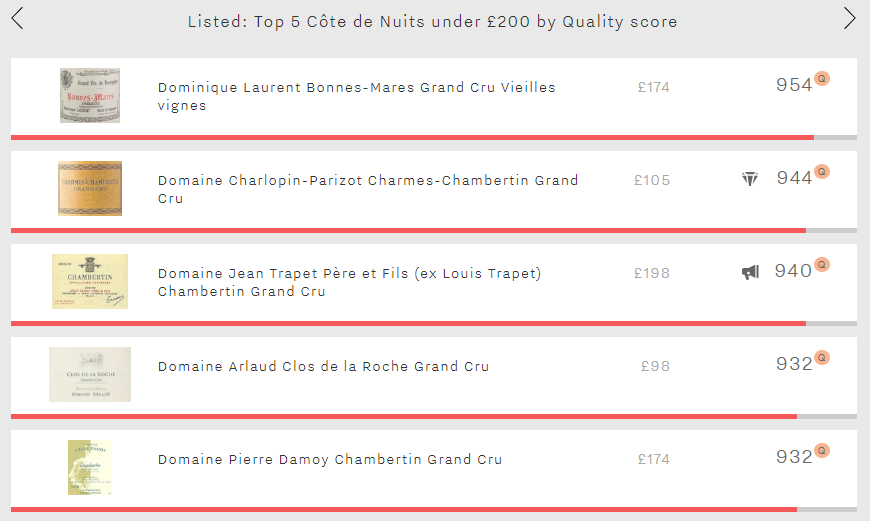
Dominique Laurent takes top spot this week with his Bonnes-Mares Vieilles Vignes, which has a Quality score of 954. Whilst this score sits comfortably amongst the highest of all Bonnes-Mares, the per bottle price of £174 does not – indeed, it is just under five times lower than the combined average price of the other eight best Bonnes-Mares on Wine Lister. Perhaps the lower price can, at least in part, be explained by its modest Brand score (531). For example, despite its Quality score sitting just one point higher, Georges Roumier’s Bonnes-Mares records a Brand score of 934, and is £1,046 more expensive.
In second place is Domaine Charlopin-Parizot’s Charmes Chambertin, with a Quality score of 944. Its high quality is not yet accompanied by an equal level of consumer recognition. With the lowest Brand score of the five (445) resulting from presence in only 2% of the world’s best restaurants and a search frequency ranking of 2,335 (of the c.4000 wines on Wine Lister), this Charmes Chambertin is a Hidden Gem (Wine Lister’s indicator that identifies under the radar wines that warrant discovery).
Domaine Jean Trapet Père et Fils’ Chambertin takes third place this week with a Quality score of 940 and just sneaking in under the £200 mark. While in third place for Quality, it has the highest overall Wine Lister score of the lot (906), thanks to its Brand (868) and Economics (896) scores. Indeed, it beats the combined average scores of the other four wines in this week’s top five in both categories by 310 and 319 points respectively.
The remaining two spots are taken by Domaine Arlaud Clos de la Roche, and Pierre Damoy Chambertin, each with a Quality score of 932. In addition to being by far the cheapest option of this week’s top five (£98 per bottle on average), Arlaud Clos de la Roche’s price is also the most stable, with volatility of just 5.7%. Conversely Damoy Chambertin’s price is the most volatile (8.7%), possibly the result of strong growth rates over both the long and short-term, having recorded a three-year compound annual growth rate of 15.6% and having added 6.5% to its price over the past six months alone.










